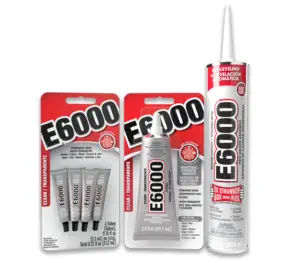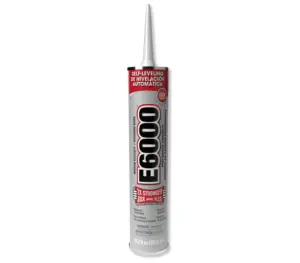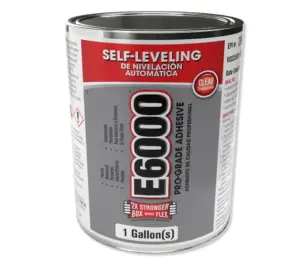You’re about to use E6000 for a project that will probably be exposed to extreme heat. So, the question that popped up is E6000 flammable?
No, E6000 is not flammable. One of the main ingredients of E6000, which is tetrachloroethylene, is not flammable. From that, E6000 gets its non-flammability. Although there are other ingredients in E6000 that have flammable properties, the end product is not flammable.
In the next sections, we will discuss in detail the flammability of E6000.
Why Is E6000 Not Flammable?
The main ingredient in E6000 is tetrachloroethylene, which is non-flammable. That’s what makes the E6000 adhesive non-flammable. Tetrachloroethylene is a colorless liquid that’s commonly used in dry cleaning and metal degreasing.
Well, how does it work in E6000? Tetrachloroethylene acts as a solvent, helping the adhesive spread smoothly and giving it that sticky goodness. It evaporates quickly, leaving behind a strong bond between whatever you’re sticking together.

Because of Tetrachloroethylene, you can accidentally expose E6000 to a spark or an open flame. Still, it won’t burst into flames like a firecracker.
However, the other ingredient in E6000 is Styrene/Butadiene copolymer. This ingredient is flammable. But when mixed with Tetrachloroethylene and other chemicals to create E6000, it loses its flammability.
Dry shampoos are also similar in texture to E6000 and just like E6000, dry shampoos are also non-flammable.
Can E6000 Withstand Heat?
Yes, on top of being non-flammable, E6000 can withstand heat very well. The ideal application temperature range is between 50 to 90 °F (10 to 32 °C). When fully cured, the adhesive can actually handle temperatures ranging from -40 to 180 °F (-40 to 82 °C).
But the best thing about E6000 is that even when withstanding the high temperatures, it doesn’t lose its ability to stick. This means that even in hot conditions, you can trust E6000 to keep things firmly stuck together.

Whether you’re crafting, repairing, or creating a DIY masterpiece, E6000’s heat resistance will ensure your work lasts.
What Is E6000 Glue Used For?
E6000 is a powerful industry-level glue, that can be used to fix virtually anything. Metal, ceramic, wood, glass, plastic, fabric, vinyl, rubber—you name it, and E6000 can handle it!
Since it is non-flammable and heat-resistant, you can use it on products that are exposed to flames and heat. Such as kitchen appliances, electrical appliances, etc.
But if you are using E6000 on a flammable object, it may be a different scenario. For example, if you use E6000 to repair your turfs that may be flammable, it may not work.
Other than being non-flammable and heat-resistant, E6000 is also waterproof and vibration-proof. So, if you need to fix something that moves a lot or is submerged, you don’t need to worry.
What Should You Not Use E6000 On?
It is prohibited by the manufacturer to use E6000 on polystyrene, polyethylene, polypropylene, Styrofoam, or paper products.
Let’s break it down a bit. Polystyrene which is found in materials like foam cups and packaging, doesn’t go with E6000. The same thing applies to polyethylene and polypropylene. These are found in plastic containers, bottles, and also packaging materials.

Styrofoam which is often used for craft projects or as protective packaging is also a no-go for E6000. Its structure doesn’t mesh well with the adhesive. That’s why it’s best to explore other adhesives when working with Styrofoam.
Last but not least, E6000 doesn’t work on paper products. The adhesive’s formulation does not work with paper, which leads to poor bonding.
How To Safely Use E6000?
Although effective, E6000 can be toxic. So, you need to be careful when using it. To ensure a safe experience with E6000, you must follow these step-by-step directions-
- Before applying E6000, test it on a small area or scrap material to ensure compatibility and the desired results.
- Make sure that the surface you’ll be working on is clean, dry, and free of any dirt or debris. For optimal adhesion, lightly roughen the surface before applying the adhesive.
- If you’re using a tube of E6000, puncture the inner seal by using the pointer cap. In the case of a cartridge, trim the end of the nozzle and puncture the inner seal as well.
- Take note of the recommended application temperature range. The range is ideally between 50 to 90 °F (10 to 32 °C).
- Even if E6000 is not flammable, you should still practice fire safety for the worst cases. Fire alarms can come in handy for this purpose. FSP-951 and FSP-851 can be two excellent products.
- Apply the E6000 adhesive directly to the surfaces you want to bond or repair. Take care to apply the appropriate amount for the task at hand.
- Allow the adhesive to cure for a minimum of 24 hours. However, maximum bond strength may not be reached until up to 72 hours have passed.
- If you want to easily remove the tube cap, apply a thin coat of petroleum jelly. Apply it to the threads of the tube before replacing the cap. For a cartridge, cover or plug the opening of the nozzle.
- If you accidentally spill the adhesive, clean it up using acetone or citrus-based solvents as soon as possible.
By following these steps, you’ll ensure the safe and effective use of E6000 adhesive.
Frequently Asked Questions (FAQs):
Is E6000 gas-proof?
No, E6000 is not completely gas-proof. While it does some resistance to gasoline, some people claim that it is not effective against gasoline. So, you should exercise caution when using E6000 around gasoline or similar substances.
Is E6000 stronger than hot glue?
Yes, E6000 is generally considered to be stronger than hot glue. E6000 has a higher tensile strength and is often described as having a more permanent bond. However, hot glue may be more versatile and easier to use for certain projects.
Is E6000 waterproof when dry?
Yes, E6000 is known to be waterproof once it is fully cured or dried. Once the adhesive has fully set, it forms a strong and durable bond. That bond is resistant to water and can withstand exposure to moisture. This characteristic makes E6000 suitable for various applications that require waterproofing
Conclusion
So, now you have the answer to your question, “is E6000 flammable? Since it is not flammable, you can use it for projects that can be exposed to flames.
But E6000 is pretty toxic and can cause skin or eye irritation. So, you better be careful when using this product for your projects.
Happy crafting!

